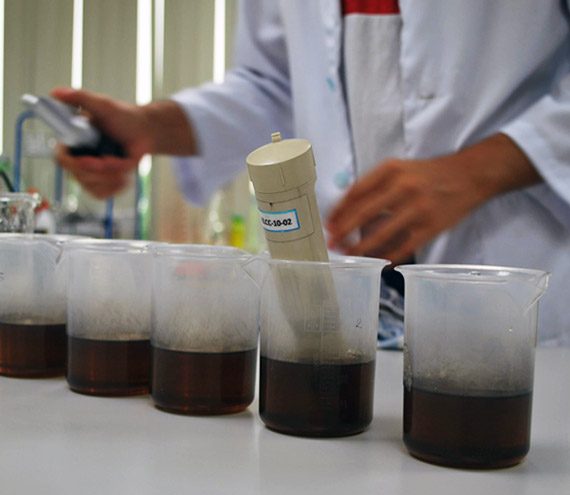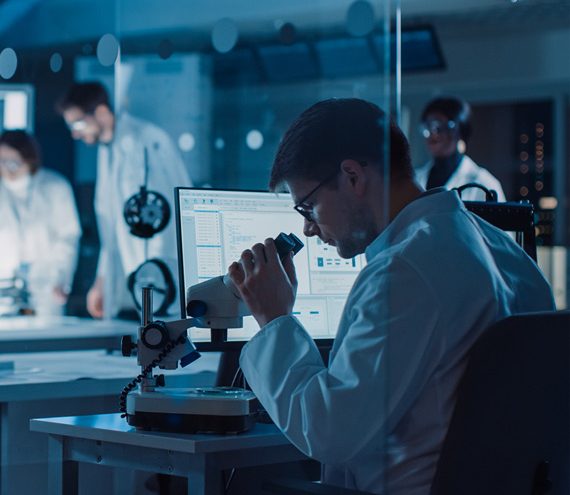Discover how Carbo Solution International innovative products significantly advance our customers’ operational performance – from improving sugar manufacturing efficiencies and raising product quality, to maximizing sugar production and reducing effluent treatment and energy consumption.
Case Study 1: Pan Decolorant at Sugar Mill
This case study describes the alternative process presented by CarboUA for the treatment of A- massecuite in one of the raw mills in Thailand. The mill has a capacity of 17,000 TCD and the objective of this study is to prove the efficiency of HPD to improve the decolorization and increase the sugar yield.
Proposed solutions by CarboUA:
- To improve Boiling House operations with the use of CarboUA S-Type 20 and S-Type 10 products in Crystallization Station in A-massecuite at batch pan and CVP
- Improve the color of A-Sugar and increase the sugar
| A-SUGAR | B-SUGAR | |
| No Treatment | 1,430 | 3,726 |
| HPD | 1,283 | 2,557 |
| HPD | 1,226 | 2,637 |
| HPD | 1,297 | 2,307 |
| No Treatment | 1,466 | 3,302 |
| No Treatment | 1,478 | 3,699 |
| No Treatment | 1,428 | 3,894 |
Table 1. A & B Sugar Color
With application of HPD, A-Sugar colors were improved to 1,220 – 1,280 IU compared to over 1,400 IU without the HPD. While for B- Sugar colors were improved to 2,300 – 2,600 IU from over 3,000 IU.
Based on sample analysis taken from silo, evidently with application of HPD, it consistently produced lower color of A-Sugar compared to samples without treatment. It improved color by 20%.
In Table 2, A-sugar tons per day were also increased with HPD application to 1,800- 1,900 tons, compared to normally 1,600 tons without treatment at 17,000 tons crushing per day or around more than 10% increased.
| Mar 26 | Mar 27 | Mar 28 | Mar 29 | Mar 30 | Mar 31 | Apr 1 | |
| No HPD | HPD | HPD | HPD | No HPD | No HPD | No HPD | |
| Tons Cane Crushed/D |
13,865 | 17,511 | 17,249 | 17,300 | 5,117 | 17,224 | 15,750 |
| A-Sugar, Ton/D |
1,508 | 1,894 | 1,934 | 1,896 | 882 | 1,673 | 1,629 |
Table 2. Tons Cane & Tons Sugar produced.
With continues application, this will not only improved A-Sugar crystallization but will eventually improve the B and C crystallization and will lower the final molasses quantity & purity. HPD carry over in molasses will also contribute to ethanol production, as this nitrogen-based product is beneficial for yeast consumption.
Case Study 2. Carbonatation Enhancement in Sugar Refinery
Sugar refiners are now more focus to improve the cost of efficient manufacturing and optimize the revenues. By far, the simplest and most economical system to achieve these targets is through the patented HPD technology.
HPD (S-Type) have been widely used in many sugar refineries as a carbonatation enhancer. With a simple chemical dosing pump, the HPD improved the whole refinery process with the following benefits:
- Reduces the filtered carbonated liquor color by 30 % and more:
| Description | Color |
| No Treatment Filtered Liquor | 472 IU |
| With HPD Treatment of Filtered Liquor | 328 IU |
| % Color Improvement | 30.51 % |
HPD removed the liquor’s impurities and scavenged it off together with calcium carbonate cake, resulting to a lower color and high-quality clear liquor.
- Increases the IER operations cycle by 28 % and
Low color clear liquor input to IER helps the resin to extend the regeneration cycle.
The reduced IER operation cycle converts into 200,000 USD yearly savings.
| 1,000 TPD Sugar Refinery | Savings |
| Cost of Chemicals for IER | 3 USD/T Sugar |
| Improvement on IER Cycle | 20 % |
| OpEx Cost Savings | 0.6 USD/T Sugar |
| Annual Cost Savings | 200,000 USD |
- Reduces the sweet water color, thus reducing the melt liquor color:
The HPD carry-over on the filter cake sludge helped to remove the color impurities on sweet water. Consequently, the low color sweet water reduced the melt liquor color.
| Description | Sweet Water | Melt Liquor |
| No Treatment | 3,099 IU | 3,121 IU |
| With HPD Treatment | 2,271 IU | 2,554 IU |
| % Improvement | 27 % | 18 % |
- Reduces the molasses reject sent into recovery house:
| Description | Volume (m3) | Color |
| No Treatment | 38.13 | 8,944 IU |
| With HPD Treatment | 28.63 | 7,908 IU |
| % Improvement | 25 % | 12 % |
The decreased on the volume of molasses reject implies that more sugar were recovered in the refinery.
- Increases the sugar yield:
| Description | Values |
| IER Cycle no treatment | 36 hours |
| IER Cycle with treatment | 52 hours |
| % Cycle Time Increased | 44 % |
Extending the IER cycle will reduce resin purchases by 30 – 40 %; cost of effluent treatment by 30 – 40 %; and most importantly reduce the environmental impact by 50 %.
With just 1 % increase in the sugar yield, this attributes to profit growth of 600,000 USD per year.
HPD is the most promising technology nowadays to help the sugar refineries improve the existing operations & increase the gains.
Case Study 3: HPD & HPA for Sugar Refinery
Sugar refineries have long been a major source of environmental pollution, particularly due to the use of chemical agents for decolorization, particularly the high ionic wastes coming from Ion Exchange Resin (IER) process. Sugar refiners & technologists are looking for an alternative and as much as possible an eco-friendly decolorization technology.
Proposed Solutions by CarboUA
Eco-friendly technology is now available that promises to significantly reduce the environmental impact of sugar production. The HPD & HPA technology utilizes natural materials and innovative processing techniques to achieve a high degree of decolorization without the use of harmful chemicals and does not generate ionic wastes. In addition to its environmental benefits, this technology also offers economic advantages, such as reduced operating costs and increased production efficiency. As sugar refineries face increasing pressure to adopt sustainable practices, this eco-friendly decolorization technology represents a major step forward in the industry’s efforts to reduce its environmental footprint and meet the growing demand for sustainable products.
IMPROVEMENT IN THE SUGAR REFINERY PROCESS
- HPD technology helps improve the clear liquor color by 30 – 60%.
- Whereas HPA technology improves the clear liquor further to produce below 200 IU of fine liquor:
| REMELT | CARBONATED LIQUOR COLOR |
PH | CLEAR LIQUOR 1 (HPD) |
%CR | PH | CLEAR LIQUOR 2 (HPA) |
&% CR | PH |
| 1240 | 380 | 7.18 | 278 | 27% | 8.39 | 222 | 20% | 6.61 |
| 1335 | 277 | 7.84 | 196 | 29% | 9.04 | 138 | 30% | 6.96 |
| 1 | 379 | 7.11 | 250 | 34% | 7.85 | 190 | 24% | 8.50 |
| 1525 | 460 | 7.35 | 248 | 46% | 8.02 | 167 | 33% | 7.56 |
| 1240 | 417 | 7.25 | 238 | 43% | 8.34 | 147 | 38% | 7.09 |
| 1227 | 361 | 7.06 | 232 | 36% | 8.06 | 157 | 32% | 7.40 |
| 1390 | 380 | 8.39 | 289 | 24% | 8.28 | 151 | 48% | 7.10 |
| 1685 | 415 | 7.66 | 286 | 31% | 8.79 | 174 | 39% | 6.90 |
| 1650 | 402 | 7.13 | 271 | 33% | 8.69 | 180 | 34% | 7.03 |
HPD and HPA is a breakthrough technology that by-passes GAC and IER system. This technology is easy to operate, low space requirement, low capital investment cost, economical operating cost and eco-friendly with no liquid effluents.
Case Study 4: Talo-Phosphatation Refinery
This case study describes the product performance presented by CarboUA for the treatment of melt liquor at Talo-Phosphate Refinery in Thailand with refined sugar output capacity of 1,000 tons per day and with deep bed filtration and Ion Exchange Resins.
CarboUA products have special capabilities to achieve a high-quality purification of the sugar liquor at reduced dosage, thereby optimizing the full benefit of the specific products in the refinery operations.
Potential benefits that can be achieved with CarboUA products:
- An improvement in the color of Melt Liquor can be anticipated with the use of Carbo UA’s FRS-J7 or FRS-W9 by 20-30
- As a consequence, the resulting fine liquor color input to the IER Station will be lower, makes the IER cycle longer and will improve the present color profile of refined sugar
| Remelt Liquor Color (IU) |
Clarified Liquor (IU) |
% Color Removal |
% Color Improved Compared to Traditional |
|
| No Treatment | 1,339 | 1,036 | 23 % | |
| No Treatment | 1,320 | 1,016 | 23 % | |
| No Treatment | 1,389 | 1,017 | 27 % | |
| Average | 1,349 | 1,023 | ||
| FRS-W9 | 1,011 | 688 | 32 % | 32 % |
| FRS-J6 | 1,061 | 662 | 38 % | 35 % |
| FRS-J6 | 956 | 604 | 37 % | 41 % |
| FRS-J6 | 945 | 577 | 39 % | 44 % |
FRS-W9 and FRS-J7 improved clarified liquor color from the Re-melt liquor color at 32 – 44% removal as shown in the table. Summary of Clarified Liquor Color improved the liquor to 557 – 688IU or about 32 – 36% compared to traditional clarification process (without decolorant) which liquor color were over 1,000 IU. This color profile of clarified juice will be further improved after the multi-bed filter as the carry over flocs will be removed in this station.
A lower color load of clear liquor will improve the cycling time of IER and will eventually improve also refined sugar quality.
Phosphoric Acid consumption:
| No Treatment | FRS-W9 FRS-J6 Treatment | |
| Average Consumption, Kg/Day | 564.78 | 453.34 |
| % Improvement | 20 % |
Consumption of phosphoric acid was also reduced by 20 %.
Although, FRS-W/J products has been widely used in some countries including most applications in Pakistan, Columbia, and other countries but this promising result justified that even with Thailand’s type of liquor, FRS- W/J proved significant solution in improving the quality of liquor in the process.





